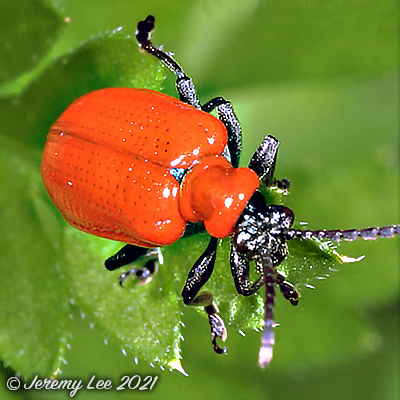
 |
|
Scientific Classifications explained » Amphibians » Ants » Aphids » Bees » Beetles » Birds » Bugs » Butterflies » Caterpillars » Damselflies » Dragonflies » Earwigs » Flies » Frog/Leafhoppers » Fungi » Galls » Grasshoppers » Harvestmen » Hoverflies » Lacewings » Ladybirds » Leaf Mines » Lichens » Mammals » Millipedes » Mosses » Moths » Sawflies » Slugs » Snails » Spiders » Trees & Shrubs » Wasps » Wild Flowers » Woodlice » Postboxes |
UK Nature > Beetles > Lilioceris lilii

Scientific Name: Lilioceris lilii Common Name: Scarlet Lily Beetle Once very rare, Lilioceris lilii, or the Scarlet Lily Beetle, has in the last 30 years become widespread throughout the south east; rather more scattered through the West Country and Midlands to Yorkshire. Usually regarded as a pest by horticulturalists and gardeners, adults occur throughout the year, overwintering after emerging through the summer. Adults and larvae feed on lilies (Lilium spp.) and Fritillaries (but not on Haemerocallis as is sometimes believed). Adults make small holes in the leaves while larvae feed from the base of the plant working upwards until, in extreme cases, the later instar larvae consume even buds and seed cases. The mature orange larvae burrow several centimetres into the soil and pupate in silken cocoons, the adults emerging from May or June until late summer. |
|

https://www.uknature.co.uk is a website dedicated to showing the immense diversity of UK nature and wildlife. Our vast range of habitats, from lowland arable to snow covered mountains, from storm-ravaged coastlines to peaceful inland freshwater lakes and rivers, from dry, sandy heaths to deciduous and coniferous forests, all these habitats contribute to the abundance of UK nature. We have wild birds in huge numbers either residing or visiting our shores (597 recorded species as at July 2013) and we must also not forget the humble back garden with its grass lawns, flower beds filled with nectar rich flowers, shrubs and trees, all designed to attract huge numbers of insects such as bees, moths, butterflies and hoverflies; and finally the small ponds which provide safe havens for frogs, toads, newts and even slow worms and grass snakes. www.uknature.co.uk is the showcase for my personal passion, photographing uknature in all its glory. I sincerely hope you all enjoy the fruits of my labours. This site and all images contained therein is © Jeremy Lee 2004 - 2025. All Rights Reserved. Site design by Jeremy Lee. Site development & IT Support by Stuart Lee. |